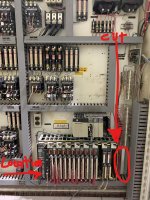Hello,
I'm starting in the PLC world, mostly doing troubleshooting and little changes to programs for the last year and a half, also have done a couple of training with AB so far.
We have a system that was originally PLC5, something failed some time ago and previous engineer replaced the processor in a hurry, leaving the system with a 1756-I55 processor and a 1756-DHRIO connected to the old 1771 chassis trough a remote I/o adapter.
The best to do, in my opinion; will be to update it all to 1756 modules, since parts are just going to be more scarce as time passes, and want to avoid the old chassis or modules failing and the need to do the same upgrade in emergency mode.
I have the option to contract this out but I would like to learn how to do it by myself instead and since no one is stressing me out to get this done by a certain date.
What would you think will be the best and quickest approach/way to achieve this upgrade?
Thanks.
I'm starting in the PLC world, mostly doing troubleshooting and little changes to programs for the last year and a half, also have done a couple of training with AB so far.
We have a system that was originally PLC5, something failed some time ago and previous engineer replaced the processor in a hurry, leaving the system with a 1756-I55 processor and a 1756-DHRIO connected to the old 1771 chassis trough a remote I/o adapter.
The best to do, in my opinion; will be to update it all to 1756 modules, since parts are just going to be more scarce as time passes, and want to avoid the old chassis or modules failing and the need to do the same upgrade in emergency mode.
I have the option to contract this out but I would like to learn how to do it by myself instead and since no one is stressing me out to get this done by a certain date.
What would you think will be the best and quickest approach/way to achieve this upgrade?
Thanks.






